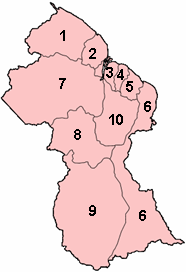Related Research Articles

Georgetown is the capital and largest city of Guyana. It is situated in Demerara-Mahaica, region 4, on the Atlantic Ocean coast, at the mouth of the Demerara River. It is nicknamed the "Garden City of the Caribbean." It is the retail, administrative, and financial services centre of the country, and the city accounts for a large portion of Guyana's GDP. The city recorded a population of 118,363 in the 2012 census.

Guyana is divided into 10 Regions:

Demerara is a historical region in the Guianas, on the north coast of South America, now part of the country of Guyana. It was a Dutch colony until 1815 and a county of British Guiana from 1838 to 1966. It was located around the lower course of the Demerara River, and its main settlement was Georgetown.

The Demerara River is a river in eastern Guyana that rises in the central rainforests of the country and flows to the north for 346 kilometres until it reaches the Atlantic Ocean. Georgetown, Guyana's largest seaport and capital, is situated on the east bank of the river's mouth. The river divides Essequibo Islands-West Demerara on the west bank from Demerara-Mahaica to the east.

The Colony of Demerara-Essequibo was created on 28 April 1812, when the British combined the colonies of Demerara and Essequibo into the colony of Demerara-Essequibo. They were officially ceded to Britain on 13 August 1814. On 20 November 1815 the agreement was ratified by the Netherlands. On 21 July 1831 Demerara-Esequibo united with Berbice as British Guiana.

The capture of Demerara and Essequibo was a French military expedition carried out in January 1782 as part of the American Revolutionary War. In 1781 Admiral Lord Rodney sent two sloops from his fleet at Sint Eustatius to take possession of the Dutch colonies of Essequibo and Demerara. In 1782 the French successfully took possession of these settlements, compelling British Governor Robert Kingston to surrender. The Treaty of Paris in 1783 restored these territories to the Dutch.

Phiditiidae is a family of moths. The family used to be placed as a subfamily (Phiditiinae) in the family Bombycidae.
Rolepa is a genus of moths of the family Phiditiidae. The genus was erected by Francis Walker in 1855.
John Murray was an Irish-born British Army officer and colonial administrator in British North America and South America. Murray joined the British Army in 1760 and rose to the rank of brigadier general in 1796. He was also an administrator of Cape Breton from 1799 to 1801.
Rolepa castrona is a moth in the Phiditiidae family. It was described by Schaus in 1920.
Rolepa erica is a moth in the Phiditiidae family. It was described by Schaus in 1927.
Rolepa nigrostriga is a moth in the Phiditiidae family. It was described by William Schaus in 1920.
Rolepa fiachna is a moth in the Phiditiidae family. It was described by Schaus in 1927.
Rolepa medina is a moth in the Phiditiidae family. It was described by Paul Dognin in 1916.
Rolepa lojana is a moth in the Phiditiidae family. It was described by Paul Dognin in 1916.
Rolepa marginepicta is a moth in the Phiditiidae family. It was described by Paul Dognin in 1914.
Rolepa sicyata is a moth in the Phiditiidae family. It was discovered by Paul Dognin in 1901 in Santa-Cruz, Brazil. Dognin describes this moth as having yellow, green, and pale lilac hues.
Rolepa unimoda is a moth in the Phiditiidae family. It was described by Paul Dognin in 1923.
Rolepa delineata is a moth in the family Phiditiidae. It was described by Francis Walker in 1855.
Rolepa innotabilis is a moth in the family Phiditiidae. It was described by Francis Walker in 1865.
References
- ↑ Beccaloni, G.; Scoble, M.; Kitching, I.; Simonsen, T.; Robinson, G.; Pitkin, B.; Hine, A.; Lyal, C., eds. (2003). "Rolepa demerara". The Global Lepidoptera Names Index . Natural History Museum . Retrieved May 13, 2018.